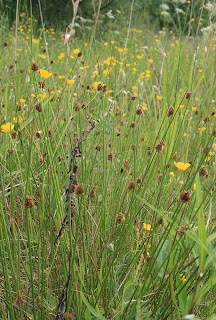
I was walking in one of our ‘wild spaces’ earlier this week and came upon the scene illustrated above. This had all the hall marks of ‘wild flower planting’ – a dubious practice that has much less merit than its adherents would like to think.
I am struck by the fact that many conservation groups seem to think that they should be planting things. Almost as soon as the ink is dry on a new group’s constitution they are out in the field planting trees and ‘wild flowers’. Pick up any local newspaper and you’ll probably find a picture of spade and trowel wielding ‘eco-warriors’ doing their bit for the environment. You will often find that these groups have been awarded grants for doing this, even though the grant-awarding bodies should really know better! The thinking seems to be that trees and flowers are now ‘rare’ and all we have to do to repair the damage is to plant some more. There’s also an unthinking assumption that any old tree or flower can be planted in any old place and it will thrive. But I can take you to at least half a dozen spots in South Manchester where wild flowers were once enthusiastically planted (sometimes there’s even a faded sign commemorating the fact) and all that is to be seen is a sad patch of docks and nettles – look at the picture above – can you see the dock leaves already sprouting in the middle?
If you must plant things (my advice is don’t!) here are some things to bear in mind:
- Your local environment is probably much richer than you give it credit for. Have you looked at it? Can you identify your local species? I estimate that, in the Mersey Valley alone, there are at least 500 species of plants growing wild – and as I keep finding new ones that’s probably a gross underestimate.
- Trees and flowers plant themselves – and have been doing very successfully for millions of years. Gardening is a great pastime and certain types of gardening (those that don’t stress excessive tidiness) can have great ecological merit; but attempting to ‘garden’ the wider environment is a mistake unless you really know what you’re doing (even many ‘professionals’ don’t seem to, as far as I can see).
- The main reason why our environment is impoverished, now, compared with the past, is because habitats have been destroyed. Since the Second World War we have lost ancient woods, hedgerows, meadows and wetlands by the score. In urban areas, like South Manchester, we are still losing the remnants of what’s left to property developers and the activities of ‘licensed eco-vandals’ (see ‘Why is the Springtime the Killing Time Around Here?’, FoCM blog, 15th May). In my experience it is often the richest habitats that are sought out and trashed – often because some bureaucrat thinks that they are ‘untidy’ (nice, safe lollipop trees planted in straight lines on closely mown, weed-free turf - the town planner’s dream!). You can’t undo that damage by planting stuff.
- Re-creating habitats is either very hard or impossible (you can’t plant an ancient wood, for example). This is why I get annoyed when I see the planting left to children. If the adults don’t know what they’re doing, children are certainly not going to – caring for the environment is not child’s play! By all means involve children in the environment, give them the opportunity to play in it and interact with it, and give them a good, well-grounded environmental education – but telling them that we can mend the damage that has been done to the environment, by previous generations, by just planting any old stuff anywhere is just wrong! It is mis-education.
- Inappropriate planting can actually damage the environment. In the Mersey Valley, in the 1970s, we lost hundreds of acres of irreplaceable, species-rich, unimproved grassland to inappropriate tree planting – and all we’re left with is a lot of spindly trees with an impoverished ground flora. The plants in the photograph are actually corn field weeds from an unknown source. We once had corn fields in South Manchester, but these are long gone. Interestingly, in some places, the seed bank still appears to be in the soil – so our original corn field weeds still spring up occasionally when the ground is disturbed. If the plants in the picture are from foreign sources (as they often are) then that genetic legacy could be diluted or lost.
So, if you’re a keen, committed, green eco-warrior, what should you be doing? Here are some suggestions:
- Get to know your local environment and find out what habitats it contains and which are worth conserving.
- Learn to identify the plants (everything else depends on these). Start by equipping yourself with a good field guide (see my review of the new ‘Collins Flower Guide’, FoCM blog, 29th May ).
- Keep good records.
- Draw up a long-term, ecologically sound management plan for any area for which you have some responsibility; get advice on this if necessary.
- Start nagging your indigenous bunch of ‘licensed eco-vandals’ to stop trashing your local environment, at the wrong time of year, and to start following the letter of the law by working to conserve and enhance local biodiversity. Persuade them to draw up long term, ecologically sound management plans for the areas for which they are responsible.
- Compile a list of things to do and move ‘planting stuff’ from number one on the list to number 1,823 – or, better still, remove it from the list altogether!
Dave Bishop, June 2009


















